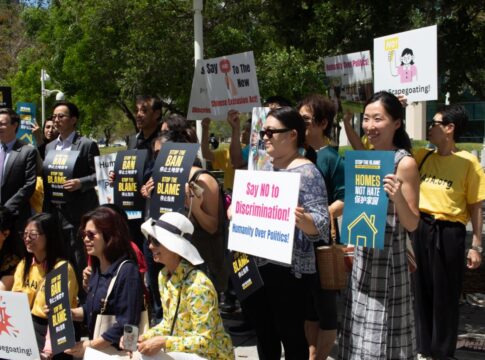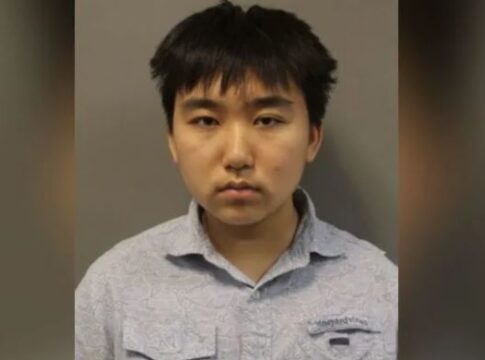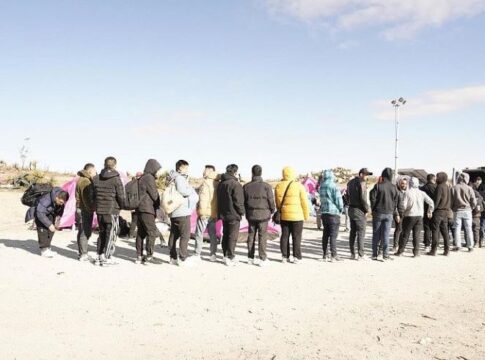By Jana Monji, AsAmNews Art & Culture Writer
This week the film Breakfast at Tiffany’s was in the news because in the UK, Channel 5 decided to cut all the scenes featuring Mickey Rooney’s yellow face role, Mr. I.Y. Yunioshi. Channel 5 is a British free-to-air television network.
The film has long been criticized as racist for Rooney’s bucktoothed portrayal of a Japanese man with a heavy accent portrayed for laughs.
In the novel, the character Yunioshi is a device that brings the narrator of the book back to his old neighborhood and opens up the story of the past.
I think it is notable that the narrator in the book states that Yunioshi comes from California and not Japan. The text gives no evidence that Yunioshi was a comic figure who badly mangled the English language with his accent. He could have been an American-born person of Japanese descent.
LATEST STORIES
The film is a romantic comedy directed by Tulsa-born Blake Edwards. At the Academy Awards, it won Best Music Score of a Dramatic or Comedy Picture for Henry Mancini and Best Original Song for Mancini and Johnny Mercer (Moon River).
Despite the offensive nature of Rooney’s character, some have criticized Channel 5’s decision.
Yellowface versus Blackface
“Since blackface has already been cut from movies such as Holiday Inn for decades (at least in the US) and the full films are available on streaming services and Turner Classic Movies, this isn’t a new practice and people can still see the full film. Instead, it would be extending an old practice that has already been in place for blackface.
The main voice raised against the decision to cut Mickey Rooney’s role from Breakfast at Tiffany’s seems to be Monty Python star and film director Terry Gilliam. According to the DailyMail.com, Gilliam said:
Censorship seems to be a growth industry in Britain these days, but to remove scenes of characters from films that had already survived the critical eye of past official censors seems absurd and dangerous. Who are the new censors? Who has given them the right to bowdlerize?
Gilliam has been lamenting the trials of being a White man for a few years. In 2018, while promoting his new film, The Man Who Killed Don Quixote, he said, “I no longer want to be a White male. I don’t want to be blamed for everything wrong in the world: I tell the world now I’m a Black lesbian.”
In reporting on Channel Five’s censorship for Breakfast at Tiffany’s, the Daily Express got a quote from Sir Richard Eyre while the Daily Mail used quotes from Rooney prior to his death in 2014, Blake Edwards prior to his 2010 death, and Katharine Hepburn’s son, Sean Hepburn. Why didn’t the Daily Mail or the Daily Express query someone of East Asian descent?
According to the New York Times article “Blackface on British TV Finally Faces a Reckoning,” British TV has been facing criticism about blackface. According to the article, Blackface on British TV is associated with a popular variety show called The Black and White Minstrel Show. Contemporary shows that were pulled because of Blackface included The League of Gentlemen” (1999-2002, three series), Little Britain (2003-2007, three series), and The Mighty Boosh (2004-2007, three series). The John Cleese comedy Fawlty Towers (1975 and 1979, two series) episode was taken off a streaming service (UKTV).
- Blackface on British TV Finally Faces a Reckoning
- Why Little Britain has been shelved over blackface backlash
For a fuller discussion of “Breakfast at Tiffany’s: The Novel” visit my blog.

Perhaps the better question is who was given permission to bowdlerize history and literature to omit minorities and people of color? In the US as well as in the UK, there’s often an alarming absence of Asians, East, and West. That’s certainly true for the recent TV series Around the World in 80 Days shown on BBC One and currently on PBS. I’ve watched numerous World War I dramas out of the UK and the US and even France, but I don’t remember one that addressed the sacrifice and prejudice faced by the Chinese Labour Corps (Corps de Travailleurs Chinois or 中國勞工旅 Zhōngguó láogōng lǚ). The CLC were about 140,000 Chinese workers recruited for support work and manual labor by both the British and French military forces.
Asia has often been omitted from much of Western interpretation of history in television and cinematic productions and with Chinese as 20 percent of the world population, people of East Asian descent have been omitted from this visual history or only used as a background. They are too often absent in even programming depicting the future. Why complain about the absence of one highly questionable portrayal of a person of East Asian descent played by a White person (Mickey Rooney) under the direction of a White person (Blake Edwards) as written by someone of Russian Jewish and English/Scottish descent (George Axelrod) based on the writings of a White man, Truman Capote, and not complain about the continued absence of people of Asian and, in light of the rise of anti-Asian hate, especially people of East Asian descent, from films and television?
The film was released on 5 October 1961 and is set in that time period.
In the same year that Breakfast at Tiffany’s was released, Flower Drum Song would become the first major film with a predominately Asian American cast. Yellow face was also present in other films that year: Christopher Lee would portrayed a Chinese person in two films (The Devil’s Daffodil and The Terror of the Tongs). Eventually, David Carradine would be the White face behind a supposedly biracial character in Kung Fu (1972-1975) and yellow face would continue to be acceptable, even in movies where blackface would not (“Cloud Atlas,” 2012).
Streaming classic films online, I’ve been able to see many classic films in their full theatrical version, including the 1942 Holiday Inn with a segment where Bing Crosby crones in blackface. The blackface scenes have been edited out of advertiser-supported network airings of Holiday Inn since the 1980s in the US.
The issue in the UK seems slightly different than in the US because in the UK, Netflix, the BBC iPlayer and Britbox streaming services completely removed some series and because the demographics of their population is significantly different from the US.
The UK is 87.2 percent White, Black/African/Caribbean/Black British at 3 percent, Asian Indian 2.3 percent and 1.9 percent Pakistani/British. The Black/African/Caribbean/Black British represent an even lower percentage of the population than Asian Americans in the US.
For the full essay on Breakfast at Tiffany’s and Mickey Rooney’s Yunioshi visit my blog: AgeOfTheGeek.org.
AsAmNews has Asian America in its heart. We’re an all-volunteer effort of dedicated staff and interns. Check out our new Instagram account. Go to our Twitter feed and Facebook page for more content. Please consider interning, joining our staff, or submitting a story, or making a contribution.










Racism must be exposed, not censored.
Removing and censoring unpleasant parts of old movies is not the solution to the problem of racism in cinema, and it can even be counterproductive.
Clarifying and making the public aware of the issue is more appropriate.